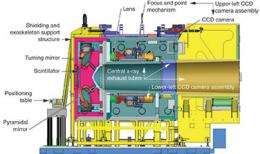Scientists develop new CT scanner to image nuclear weapon components

(PhysOrg.com) -- The Department of Energy's National Nuclear Security Administration (NNSA) has announced that it recently completed the installation and successful startup of a new surveillance diagnostic tool that is capable of detecting aging defects on critical components in the nation's nuclear weapons stockpile.
In response to NNSA's need to implement cost effective, optimized inspection of nuclear components (also known as “surveillance transformation”), scientists at Lawrence Livermore National Laboratory (LLNL) teamed with NNSA's Pantex Plant near Amarillo, Texas, to develop a new X-ray computed tomography (CT) system to image nuclear weapon components. The new CT scan will enhance NNSA's surveillance program by providing a precise non-destructive means for the detection of aging phenomena on nuclear weapon components for evaluation of potential impact, and to provide a basis for assuring a high level of confidence in their continued performance.
“This new system is a prime example of NNSA's ability to leverage the best science and technology in the world to solve complex national security challenges and highlights our commitment to transforming a Cold War nuclear weapons complex into a 21st century nuclear security enterprise,” said NNSA Administrator Thomas P. D'Agostino. “We are fortunate to have dedicated scientists working together from across the nuclear security enterprise to develop cutting-edge tools to monitor aging in critical weapon components.”
This new, state-of-the-art nondestructive tool is similar in concept to CT scanners used by doctors and hospitals to get a view inside the human body without exploratory surgery.
Called CoLOSSIS (Confined Large Optical Scintillator Screen and Imaging System), this new high-resolution imaging system is used to scan weapons components to identify any anomalies that require additional attention. The system's software assembles the collected digital radiographs into a large three-dimensional image that scientists can analyze to discover any problems or anomalies.

After nearly a decade of designing and testing at LLNL, the CoLOSSIS installation and qualification was completed in September 2009 at Pantex. The project was managed and supported through NNSA's Enhanced Surveillance and Core Surveillance Programs.
This new capability will be used to detect structural variations arising from so-called “birth defects” or from the aging effects. One key feature of this state-of-the-art, nondestructive tool lies in the fact that it conserves valuable resources and assets by eliminating some destructive procedures and disassembly operations. Future inspections at Pantex will generate detailed, high fidelity surveillance data for scientists at LLNL and Los Alamos National Laboratory (LANL). This tool and the associated data that it generates represent a substantial improvement to NNSA's approach to conducting surveillance.
LLNL became the first user of the CoLOSSIS system in support of core surveillance of weapons known as B83 and W87. Core project team members included Patrick Allen, Mark Lane, Gary Stone, Dan Schneberk and Jim Trebes at LLNL, and Mitch Carry, Joe Olsen, Bruce Slattery, Randall Hodges at Pantex.
LANL will be next to use CoLOSSIS in support of pit surveillance activities for the Air Force's B61 gravity bomb. Inspectors at LANL will assess these components for aging and manufacturing or other defects, and will be provided with never before seen three-dimensional characterizations of the components. Scientists will use the valuable data to develop surveillance assessments that could be used in future Life Extension Programs.
Provided by Lawrence Livermore National Laboratory
















